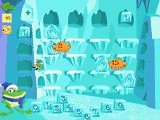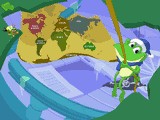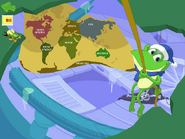The Ice Cave is a location and an activity in JumpStart 2nd Grade. It is accessed by clicking on the 'Ice Cave' button at the elevator. It is designed to teach math skills and geography for second grade.
Characters
Description
In this activity, various bugs with numbers on them roam around in a sixteen-unit grid. the player must use ice cubes with numbers zero through nine on them, and place them around the grid to freeze the bugs.
A math symbol is located at the upper left corner of the grid, which will display either an addition, subtraction, or multiplication sign. The player must place two ice cubes so that they form an equation that equals the number on the bug. For example, if the bug's number was two, and the addition sign was displayed, the player could place a one on the left side of the grid, and a one on top of the grid, to make one plus one, which equals two.
When the bug reaches the spot where both ice cubes intersect, it will be frozen. If all of the spaces in the grid fill up with frozen bugs, a secret passage will be opened, which leads to the frozen remains of an ancient pirate ship. The penguin throws a snowball and it says "Good Job!"
At the pirate ship, the player can inspect the mariner's map to learn facts about the different continents. The mariner's map can also be used to complete pen pals' challenges.
Difficulty level differences
- Level 1 (Scout) - Addition and subtraction with numbers 0-9. Only one bug is present at a time.
- Level 2 (Explorer) - Addition and subtraction with numbers 0-9, multiplication with possible outcomes of 1, 4, 9, 16 or 25. Only one bug is present at a time.
- Level 3 (Trailblazer) - Addition and subtraction with numbers 0-9, multiplication with possible outcomes of 1, 4, 9, 16 or 25. Two bugs are present on the screen at once.
Quotes
Mariner's Map
- CJ: Look out below! I'm descending, Edison! That must be the old pirate's map.
- Edison: And those are the continents! Click on any one if you want to find out something about them.
Continents in CJ's Dialogue
- "North America: That's where we live."
- "South America: That continent is connected to North America."
- "Europe: That continent is connected to Asia."
- "Asia: That continent is connected to Europe."
- "Africa: That continent is connected to Asia."
- "Australia: That's the smallest continent."
- "Antarctica: That's the southern most continent and it's very cold there."
Digital manual description

Watch the creepy but friendly ice bugs skitter and scratch their way across the walls of the frozen cave. Place the correct numbers on the grid to create an equation which can be answered by the number on the bug. Creating a correct equation freezes one of the little critters. When the grid is filled, a secret passage opens to reveal an ancient Pirate Ship.
- Click the Start button in the upper-left corner.
- A Math symbol shown in the upper-left corner will show you which operation you need to perform to solve the equations.
- See how the Start sign on the button changes to a new sign (+, -, X).
- Click and drag the ice cubes with the right numbers to a place on each axis. When the bug scratches its way across to the intersection it freezes.
The Pirate's Ship

The remains of an ancient pirate's ship are frozen beneath the Ice Cave. The mariner's map will help you solve Pen Pal challenges.
Click on any continent to solve your challenge and/or hear a fact about that continent.
Levels
1. Scout: The Scout adds and subtracts number 0 - 9, with the greatest possible answer being 18. The bug's number will repeat until a correct answer is given.
2. Explorer: In addition to the content in the Scout Level, the level introduces, multiplication with possible answers of 1, 4, 9, 16 or 25. The bug's number will repeat twice if an incorrect answer is given.
3. Trailblazer: The Trailblazer faces 2 bugs on the screen at the same time! Also, 2 possible answers are available.
Educational and Developmental Benefits
The Ice Cave games practice math skills such as addition with 1 and 2 digits, subtraction with 1 and 2 digits, multiplication and introduction to grids.
